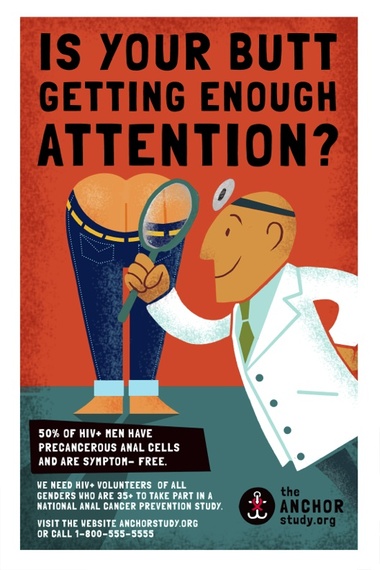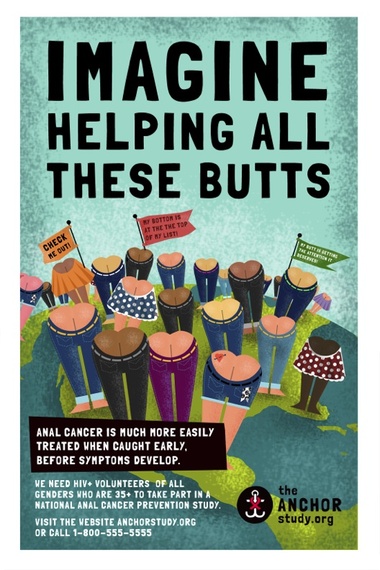About 17 years ago, Jeff Taylor, an AIDS advocate, became worried he might have anal cancer. Through his work, Taylor knew that anal cancer rates had risen steeply among people with HIV. He was having discomfort, and he knew that there was a simple screening test: a swab that is processed just like a routine pap smear.
His doctor knew about the test, but at that time there was little agreement on how to diagnose and treat anal cancer, which is rare in the general population. "He said, 'even if I sent it in, the lab wouldn't process it,'" because the pap smear specimen wasn't from a female patient, Taylor recalled.
After several biopsies, Taylor was found to have an early stage anal cancer. "I was extremely lucky," he said. "I've literally watched friends die because they didn't get diagnosed in time."
"Anal health" isn't a topic that comes up in most routine doctor visits. But many people -- specifically, those who have HIV, men who have sex with men, and women who have had precancerous changes found on routine pap screening -- are at increased risk. Over the past three decades, the incidence of anal cancer in the U.S. has doubled. Anal cancer's incidence in the general population is low, but among HIV positive men, it is higher than that of other cancers for which screening is widely recommended, such as colon cancer. Among HIV positive men who have sex with men, its incidence is even higher than that of prostate cancer, the most common solid organ cancer in men in the U.S.
"Most of the cancers that come in to us are quite large," said Dr. Stephen Goldstone, a New York City surgeon whose practice specializes in anal cancer. "The vast majority (of people at risk) aren't screened at all. Patients aren't getting rectal exams and aren't telling their doctors -- they're too embarrassed."
Most anal cancer is caused by strains 16 and 18 of the Human Papilloma Virus (HPV), which also cause cervical cancer in women. After a person is infected with HPV, anal cancer takes years to develop. Among the 1.2 million people in the U.S. infected with HIV, it has been estimated that half of men and a fifth of women have HPV-related changes in the cells of the anus. Most of these changes will resolve over time, but not all. As people with HIV live longer, more are developing anal cancer.
That's where the idea of screening for precancerous anal changes comes in. Mass screening for cervical cancer with pap smears led to a huge drop in the number of women dying of the disease, which once was among the most common causes of cancer death in the U.S. Screening for other types of cancer, such as prostate, hasn't had the same effect. To get physicians to adopt a new screening test -- and to convince insurance companies to pay for it -- a large clinical trial needs to show that it substantially reduces death and suffering without causing an undue amount of harm by leading to unnecessary biopsies and treatments.
Even though the New York State Department of Health recommends annual anal cancer screening for many HIV-infected men and women, there are no national screening guidelines. Awareness about anal cancer varies widely among doctors and nurses, and the availability of screening differs significantly in different regions of the country.
Taylor and others advocated for years for research into how to detect and treat anal cancer. In 2013 the National Cancer Institute committed $89 million to an eight-year study investigating whether treating certain HPV-related abnormalities early reduces the likelihood that a person with HIV will develop anal cancer. The study, called ANCHOR, plans to enlist more than 5,000 HIV-infected men and women at 15 sites across the country. It will also look at the molecular changes that precede anal cancer, look for certain biological clues, or biomarkers, that a person is at increased risk, and try to find new treatments.
To help recruit patients, the study team created colorful cartoon posters asking, "Is your butt getting enough attention?" and "Put your bottom at the top of your list." They also acquired a hard-to-forget phone number: 844-HIV-BUTT.
Depending on the study's results, it's possible that anal health will become a routine conversation topic between doctors and patients -- and labs won't think twice when they receive a pap smear specimen from a man.
Posters promoting the Anchor Study


